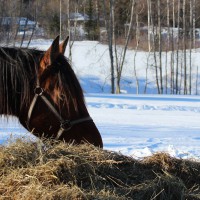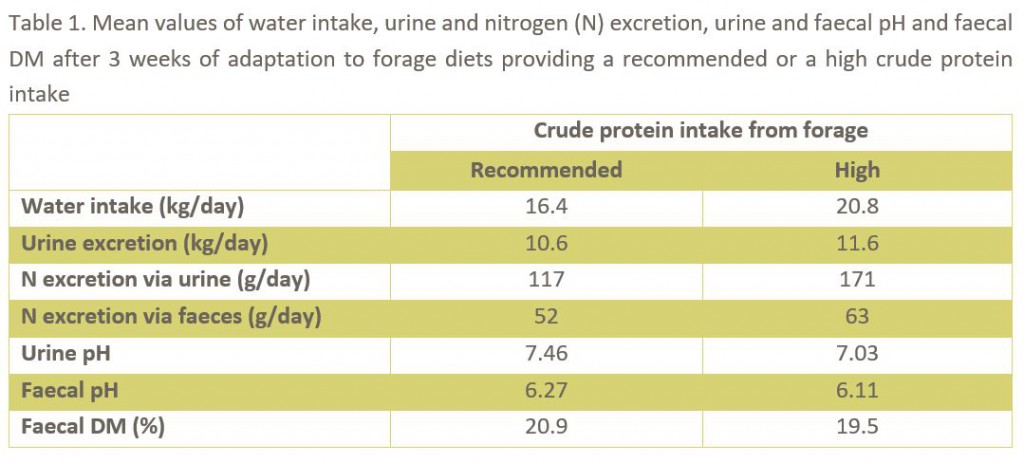Forage crude protein content and horses’ nitrogen metabolism and water intake

Early harvested forage has a high energy content but often also a high crude protein content, which can result in an excessive crude protein intake. This study examined the impact on nitrogen metabolism and water intake in trotters in training when feeding two diets that consisted of early harvested grass silage with high energy content (>11 MJ/kg DM). One silage had a high crude protein content (17% = 128 g digestible CP/kg DM) that gave an excess protein intake and the other silage (13% = 91 g digestible CP/kg DM) provided a recommended intake of crude protein.
Proteins are composed of amino acids which contain nitrogen (N), an excess intake of N cannot be stored in the body and has to be excreted. The high protein diet corresponded to an excess crude protein intake of 160% of the requirement and resulted in higher excretion of N via urine and faeces (Table 1). In addition, the plasma urea concentration was higher when the horses were fed the high protein silage which indicates an increased absorption of N and an increased N metabolism. On the high protein diet the horses had a higher water intake and urine excretion (Table 1) which indicates an impact on the fluid balance due to a higher heat production. E.g. when the body disposes of excess N heat is also produced, and to get rid of excess heat the body’s evaporation increases and therefore the water intake also has to be increased.
The increased N excretion and lower faecal pH when the horses consumed the high protein diet indicates that there was an increased fermentation in the large intestine, e.g. a higher activity of the bacterial flora. The faecal DM concentration was lower on the high protein diet, which might be due to several factors like an increased amount of N in the large intestine can affect flows of water into and out of the intestine and total water intake is correlated to faecal DM.
In this study abrupt feed changes between the high protein silage and the recommended were also performed. Already 15-18 hours after the abrupt change to the high protein diet urine pH was significantly lower and after 36-48 hours the N excretion via faeces was higher. This indicates that horses quickly begin to excrete excess N. After the abrupt change from the high protein silage to the silage that gave a recommended crude protein intake it was not until day 3 that the water intake decreased which indicates a 2 day period was needed for the excess N to be ‘washed out’.
In conclusion, an excessive intake of crude protein corresponding to 160% of the requirements the horses handled by within the first 24 h start to excrete the excess N via urine and faeces. This implicated a higher water intake and urine excretion. But does this have any effects on the horses’ performance? In this study exercise tests were performed on a treadmill and racetrack. No effects on the horses’ exercise response or recovery during and after the exercise tests could be detected and you can read about the results here.
Sara Muhonen, AgrD

